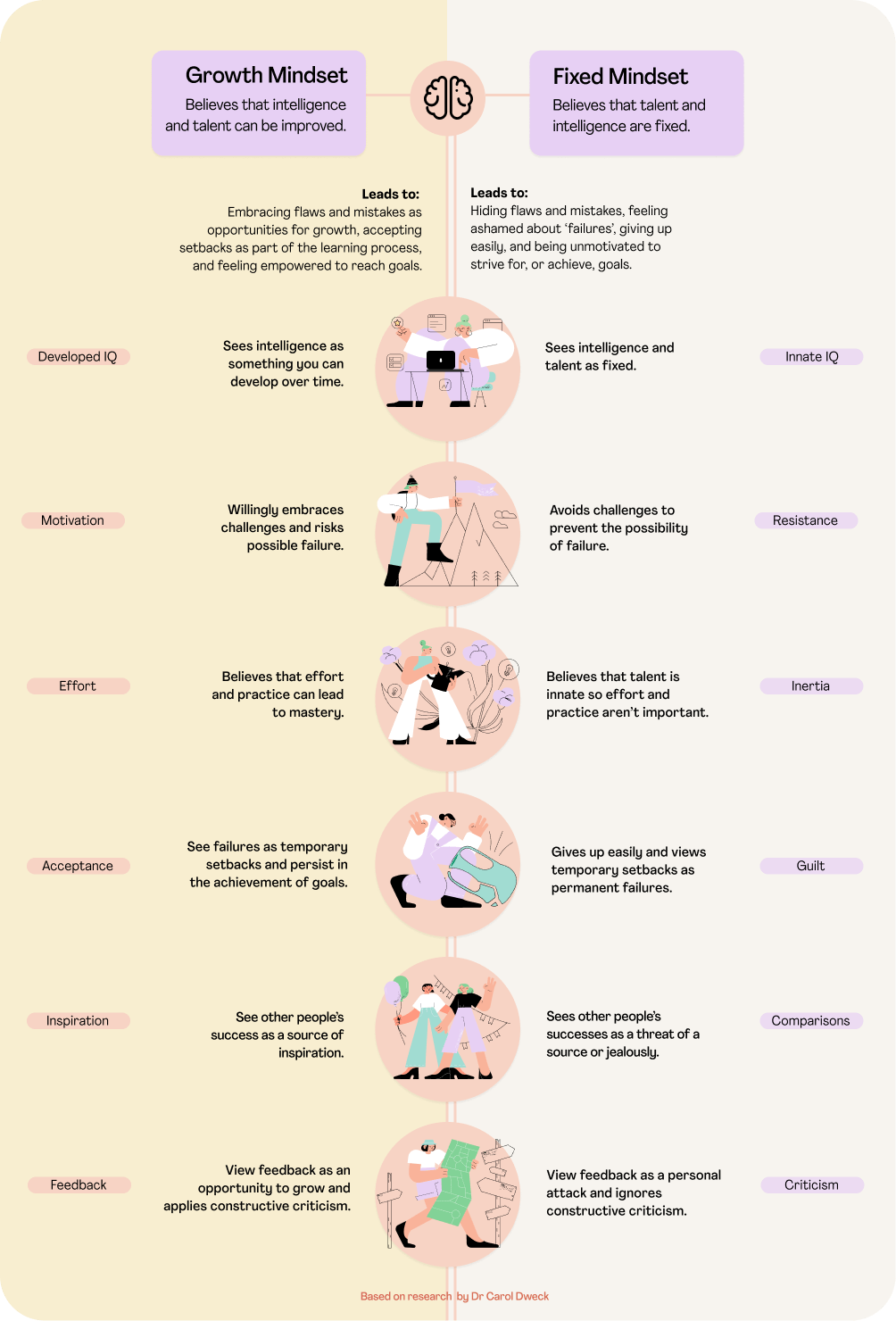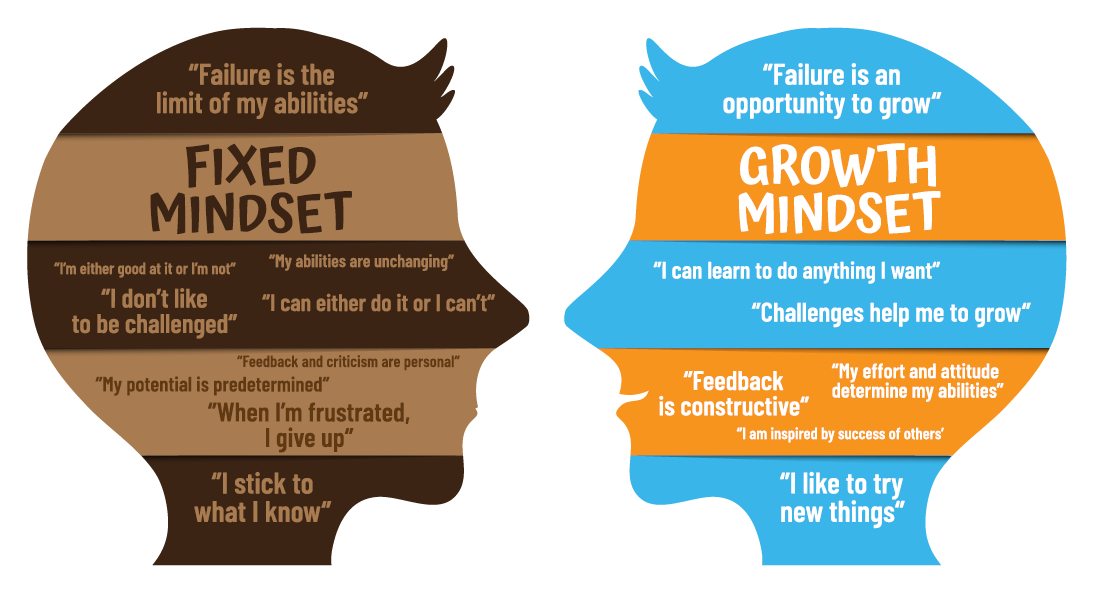Growth mindset or fixed mindset—can the way we think about ourselves and our abilities shape our lives? Absolutely. The way we think about our intellect and talents not only affects the way we feel, but it can also affect what we achieve, whether we pick up new habits, or if we will go on to develop new skills.
A growth mindset is one where you believe your intelligence and talents can be developed over time. A fixed mindset means that you believe intelligence is fixed—so if you’re not good at something, you might believe that you do not have the talent for it.
At Mathlete Training Centre, we’re all about growth mindsets and encouraging people to adopt a positive outlook on learning. So, let’s look at growth vs. fixed mindsets together, explore the science, and see how people can change their mindsets over time.

Growth vs. fixed mindsets for life
Science once told us that the human brain stops developing in childhood, however, we now know that the brain is constantly evolving and changing. Many parts of the brain respond to experiences and our mental capacity and capabilities can be updated through continuous learning.
Despite the neurological facts, some people still think that you’re stuck with the talents and ‘smarts’ you’re born with. Psychologist Carol Dweck, from Stanford University, was the first researcher to explore the idea of fixed and growth mindsets.
In Dr. Dweck’s seminal work, she described the two main ways people think about intelligence or ability as having either:
A fixed mindset: in this mindset, people believe that their intelligence is fixed and static.
A growth mindset: in this mindset, people believe that intelligence and talents can be improved through effort and learning.
People with a fixed mindset typically believe that their level of intelligence and abilities are innate. In Dr. Dweck’s own words, fixed mindset people believe that “they have a certain amount [of intelligence] and that’s that, and then their goal becomes to look smart all the time and never look dumb”.
For people with a growth mindset, however, they understand that not knowing or not being good at something can be a temporary state—so they don’t have to feel ashamed or try to prove they’re smarter than they currently are.
Dweck states that in a growth mindset, “students understand that their talents and abilities can be developed through effort, good teaching, and persistence.”
Who identified the growth mindset?
Psychologist Dr. Carol Dweck of Stanford University was the first to describe the growth mindset. In her ground-breaking research, Dweck investigated why some people fail while others succeed.
In one study, high school students were challenged with puzzles that ranged from easy to difficult. Much to the surprise of researchers, some students embraced failure and treated it as a learning experience, and this positive attitude was what Dweck later coined the ‘growth mindset’.
Dweck’s research also found, contrary to popular opinion, that it’s more beneficial not to praise talent or natural abilities but to praise the process. In particular, effort, strategies, persistence, and resilience should be duly rewarded. These processes play a major role in providing constructive feedback and creating a positive student-teacher relationship.
Dweck later noted, in a 2015 article, that while effort is an important part of a growth mindset, it shouldn’t be the main focus of praise. Effort should be a means to learning and improving. When fostering a growth mindset, continue telling yourself “great effort” after finishing a task, but also look for ways to improve next time—so you feel good in the short and long term.
The benefits of a growth mindset
Studies by Dweck and others indicate that a growth mindset has a positive effect on motivation and academic performance.
One study examined the academic enjoyment of undergraduate students after learning about the neuroplasticity of the brain.
The students were encouraged to endorse a growth mindset through three one-hour sessions on brain functioning. The control group was taught that there are several types of intelligence. Students showed significantly higher motivation and enjoyment of science after learning about the growth mindset than in the control group.
In another study, teaching a growth mindset to junior high school students resulted in increased motivation and academic performance. The researchers found a growth mindset was particularly beneficial for students studying science and mathematics.
Studies have also indicated that students who endorsed a growth mindset, rather than a fixed mindset, had higher grades in mathematics, languages, and grade point average (GPA).
The neuroscience of a growth mindset
Scientists have measured the electrical activity in the brain to understand the brain correlates of a growth mindset.
Using neuroimaging, researchers have found a link between a growth mindset and activation in two key areas of the brain:
- The anterior cingulate cortex (ACC): involved in learning and control
- The dorsolateral prefrontal cortex (DLPFC): involved in error-monitoring and behavioral adaptation
A growth mindset seems to be linked to higher motivation and error correction. It is also associated with lower activation in response to negative feedback.
Additionally, researchers have shown that in growth-minded people, the brain is most active when a person was told how they could improve — for example, tips on what to do better next time. Meanwhile, in those with a fixed mindset, the brain is active when a person is being given information about their performance – for example, the results of a test. This suggests that people with a growth mindset are more focused on the process, rather than the result.
However, only a few studies have examined the brain mechanisms underpinning different mindsets. More research is needed to clarify the precise brain activity of growth mindsets.
Can a person’s mindset change?
Just as someone can grow and develop their intellect, a person is also capable of changing brain functions and thinking patterns.
Neuroscience shows us that the brain continues to develop and change, even as adults. The brain is similar to plastic in that it can be remolded over time, as new neural pathways form. This has led scientists to identify the tendency of the brain to change through growth and reorganization as ‘neuroplasticity’.
Studies have shown the brain can grow new connections, strengthen existing ones, and improve the speed of pulse transmission. These suggest that a person with a fixed mindset can slowly develop a growth mindset.
According to Dr. Carol Dweck, you can change your mindset from a fixed mindset to a growth mindset. This is also supported by neuroscience studies demonstrating the malleability of self-attributes such as intelligence.
How to develop a growth mindset
Researchers have found that it is possible to promote a growth mindset by teaching students about neuroscience evidence showing the brain is malleable and improves through effort.
There are several ways to develop a growth mindset:
1. Realize that, scientifically, you can improve
One of the most direct methods of fostering a growth mindset is by understanding our brains are built to grow and learn. By challenging yourself with new experiences, you can form or strengthen neural connections to ‘reprogram’ your brain which, in turn, can make you smarter.
2. Remove the ‘fixed mindset’ inner voice
Many people have a negative inner voice that acts against a growth mindset. Try to flip thoughts such as ‘I can’t do this’, to ‘I can do this if I keep practicing’ to nurture a growth mindset.
3. Reward the process
Although society often rewards those who achieve excellent outcomes, this can work against a growth mindset. Instead, reward the process and the effort exerted. One study by Dr. Carol Dweck showed that rewarding effort over results on a maths game improved performance.
4. Get feedback
Try and seek feedback on your work. When students are provided with progressive feedback about what they did well and where they can improve, it creates motivation to keep going. Feedback is also associated with a pleasurable dopamine response and enhances a growth mindset.
5. Get out of your comfort zone
Being brave enough to leave your comfort zone can help foster a growth mindset. When faced with a challenge, try to choose the harder option that will allow you to grow.
6. Accept failure as part of the process
Failure, setbacks, and initial confusion are all part of the whole learning process! When attempting something new or picking up a new mathematical concept, try to see occasional ‘failures’ as positive learning opportunities and enjoy the discovery process along the way.

Ultimately, the growth mindset is the belief that intelligence and ability can be nurtured through learning and effort. Growth-minded people see setbacks as a necessary part of the learning process and bounce back from ‘failure’ by increasing effort. This mindset has positive effects on motivation and academic performance in students. The limited evidence from neuroscience suggests the brains of people with a growth mindset are more active than those with a fixed mindset–particularly in areas associated with error correction and learning.
Source: https://www.mindsethealth.com/matter/growth-vs-fixed-mindset

